Different Types Of 3-D Shapes
The figures which can be described by mentioning two dimensions called length and breadth, are called 2D-shapes or plane figures.
Example: Triangle, quadrilateral, and other polygons are all 2-dimensional figures.
3D Shapes (Solids)
The shapes like cube, cuboid, cylinder, pyramid, cone etc. which require three dimensions i.e.length, breadth and height or depth are called solid figures or 3-dimensional figures.
The objects having definite shape and size are called solids. A solid occupies a fixed amount of space and has three dimensions.
We live in a 3-dimensional world. Those objects you can see or touch has 3-dimensions as length, breadth, and height, for example, room, TV, chair, etc. In the world around us, there are many 3-dimensional geometric shapes. Here, we will learn about some of them.
Types of 3-D figures
Cuboid
It is the shape of a matchbox, a chalk box, a brick, a tile, a book, an almirah etc.
It is made of rectangles.
Definition:A solid bounded by six rectangular faces (not all equal) is called a cuboid. It has three dimensions, namely length, breadth and height.
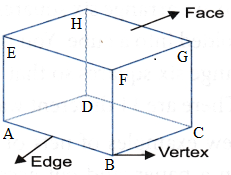 Various parts of a cuboid are
Various parts of a cuboid are
- Faces: A cuboid has 6 rectangular faces. The opposite faces of a cuboid are identical.
In figure ABCD, EFGH, ADHE, BCGF, ABFE, DCGH are faces. - Edges: Two adjacent faces of a cuboid meet in a line segment, which is called edge of the cuboid.
A cuboid has 12 edges. In figure edges are AB, BC, CD, DA, EF, GH, FG, EH, CG, BF, AE, DH. - Vertices: Three edges of a cuboid meet at a point, called a vertex. A cuboid has 8 vertices. In figure 8 vertices are A, B, C, D, E, F, G, H.
Cube
It is the shape of sugar lump, dice etc. A cube is made up of square faces.
Definition : A cuboid whose length, breadth and height are all equal, is called a cube. Length breadth and height of a cube are equal.
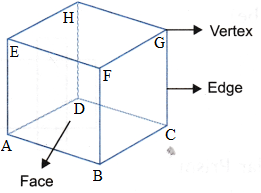 Various parts of a cube are:
Various parts of a cube are:
- Faces: A cube has six square faces. In figure, ABCD, EFGH, ADHE, BCGF, ABFE, DCGH are faces.
- Edges: A cube has 12 edges. In figure, 12 edges are AB, BC, CD, DA, EF, GH, FG, EH, CG, BF, AE, DH.
- Vertices: A cube has 8 vertices. 8 vertices are A, B, C, D, E, F, G, H.
Cylinder
A solid shape in which top and bottom both are circular while the rest of the surface is curved.
It is the shape of a tube light, tin container, circular pillars, circular pipes, circular pencils, measuring jars, road rollers and gas cylinders etc.
 Parts of a cylinder:
Parts of a cylinder:
- A cylinder has no vertex.
- A cylinder has two curved edges (in figure C1 and C2).
- A cylinder has one curved face and two flat faces (in figure F1 and F2).
Cone
A cone is a solid shape having a plane circular end as the base and whole lateral surface is the curved surface tapering into a point, called the vertex of the cone.
 Parts of a cone:
Parts of a cone:
- A cone has one vertex.
- A cone has one curved edge.
- A cone has one curved face, and one flat face.
Sphere
A solid (3-D) shape that has only a curved surface is called sphere.
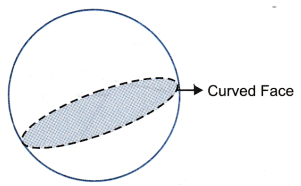 Parts of a sphere
Parts of a sphere
- A sphere has no vertex.
- A sphere has no edge.
- A sphere has a curved surface.
Prism
A prism is a solid whose bases are identical polygon faces (triangles, quadrilaterals, pentagons etc.) and the other faces are rectangles.
Remember that if the bases of the prism are pentagon, then the prism is known as pentagonal prism.
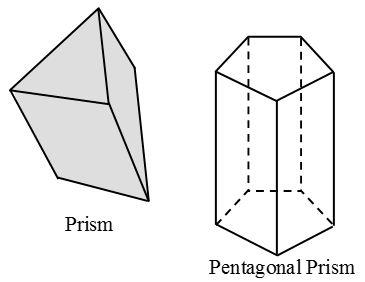
Triangular Prism
A triangular prism is made up of two triangles at each end and three rectangles. A ridge tent is an example of a triangular prism.
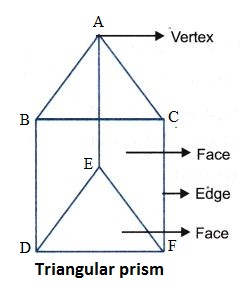 Parts of triangular prism :
Parts of triangular prism :
- It has 6 vertices A, B, C, D, E and F.
- It has 9 edges. The edges are AB, BC, AC, DE, EF, FD, BD, CF and AE.
- It has 5 faces. In figure, ABC, DEF, ABDE, AEFC, BDFC are faces.
Note :
Cube and cuboid are also called square prism and rectangular prism respectively.
Pyramid
A pyramid is a solid whose base is a flat rectilinear figure and whose side faces are triangles having a common vertex outside the surface of the base. This shape is usually found in ancient Egyptian sculptures.

Triangular Pyramid
A triangular pyramid (tetrahedron) is a solid which stands on a triangular base. It tapers to a point called the vertex of the pyramid. A pyramid is called triangular pyramid if its base is a triangle.
A triangular pyramid in which all faces are equal is called tetrahedron.
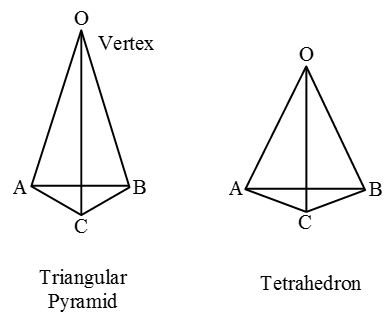 Parts of triangular pyramid :
Parts of triangular pyramid :
- It has 4 vertices (in figure A, B, C, O).
- It has six edges. In figure edges are AB, BC, AC, OA, OC, OB.
- It has 4 triangular faces. In figure, the faces are ABC, OAB, OCB, OAC.
Square pyramid
A square pyramid is a solid which stands on a square base. Its side faces are triangles having a common vertex, called the vertex of the Pyramid.
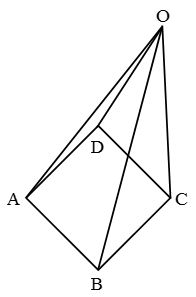 Parts of square pyramid :
Parts of square pyramid :
- It has 5 vertices. In figure, the vertices are O, A, B, C and D.
- It has 8 edge. In figure, the edges are OA, OD, OC, OB, AB, BC, CD, AD.
- It has 5 faces. In figure, 4 triangular faces and 1 square face which are OAB, OBC, OAD, OCD and ABCD.
Rectangular Pyramid
A rectangular pyramid is a solid which stands on a rectangular base. It also tapers to a point. Its side faces are triangles having a common vertex, called vertex of the pyramid.
 Parts of rectangular pyramid :
Parts of rectangular pyramid :
- It has 5 vertices.
- It has 8 edges.
- It has 5 faces.
Note :
(i) A pyramid is named according to the shape of its non-triangular face.
(ii) All the side faces of a pyramid (triangular, rectangular, square, pentagonal etc.) are triangular.
The following table gives the summary of all above observations:
| Solid | Name | No. of Vertices | No. of Edges | No. of Faces |
 | Cuboid | 8 | 12 | 6 |
 | Cube | 8 | 12 | 6 |
 | Cylinder | – | 2 | 3 |
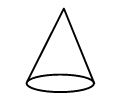 | Cone | 1 | 1 | 2 |
 | Sphere | – | – | 1 |
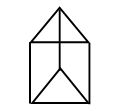 | Triangular Prism | 6 | 9 | 5 |
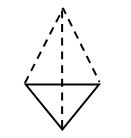 | Triangular Pyramid | 4 | 6 | 4 |
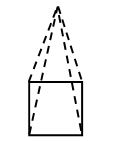 | Square Pyramid | 5 | 8 | 5 |
 | Rectangular Pyramid | 5 | 8 | 5 |
